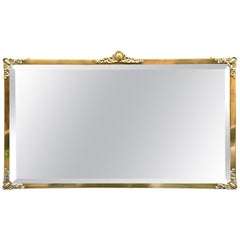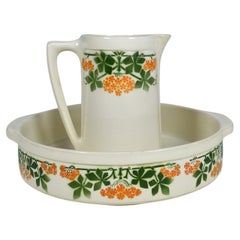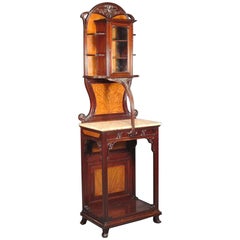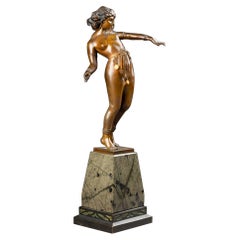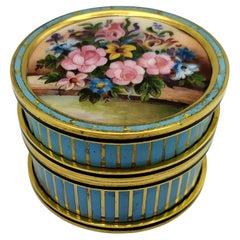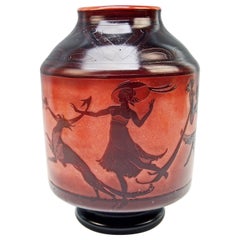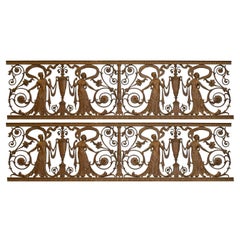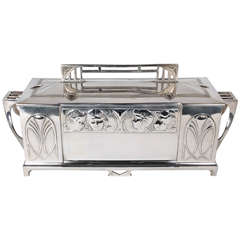Art Nouveau Frieze
Rectangular Art Nouveau Mirror with Brass Frame and Friezes, Early 1900
Located in Florence, IT
Rectangular Art Nouveau mirror with brass frame and brass friezes. Beveled original mirror, brass
Category
Early 20th Century Italian Art Nouveau Wall Mirrors
Materials
Brass
$785
H 17.33 in W 30.71 in D 0.79 in
Art Nouveau Toilet Set, Lunéville K & G, circa 1900
By Luneville Freres
Located in VÉZELAY, FR
green and yellow floral frieze.
Art Nouveau, France, circa 1900.
Signed Keller & Guérin Lunéville
Category
Antique Early 1900s French Art Nouveau Pitchers
Materials
Earthenware
Art Nouveau Carved Walnut inlaid & glazed Salon Cabinet by Louis Majorelle
By Louis Majorelle
Located in London, GB
to a further carved frieze and Art Nouveau inlaid peacock style scroll details on Maple veneers
Category
Early 20th Century French Art Nouveau Cabinets
Materials
Walnut
$9,622 / item
H 80 in W 25 in D 16.5 in
Carl Kauba : "Salomé", Rare patinated and ornamented Bronze - Early XXth C.
By Carl Kauba
Located in SAINT-OUEN-SUR-SEINE, FR
friezes
Austria, Art Nouveau period, circa 1910
Dimensions
Height 32 cm (including base 11 cm
Category
Vintage 1910s French Art Deco Figurative Sculptures
Materials
Marble, Brass, Bronze, Copper
$9,338
H 12.6 in W 4.73 in D 3.75 in
Table Box floral miniature fire-enameled on guilloche vertical stripes Salimbeni
By Salimbeni, Franco Salimbeni
Located in Firenze, FI
paillons motif.
FLORAL MINIATURES – ART NOUVEAU
The heavy friezes and ornaments of the Empire style
Category
Vintage 1960s Italian Napoleon III Decorative Boxes
Materials
Gold, Gold Plate, Sterling Silver, Enamel
$4,927
H 1.78 in Dm 2.64 in
Daum Frères Nancy Cameo Vase by Georges de Feure Frieze Figurines 1925
By Daum, Georges De Feure
Located in Vienna, AT
Made circa 1920-1930 (= Transition Period From Art Nouveau To Art Deco)
Design & manufactory
Category
Vintage 1920s French Art Nouveau Glass
Materials
Glass
Recent Sales
Art Nouveau Bronze Figural Frieze Set from The Biltmore Hotel
Located in Salt Lake City, UT
A set of bronze figural frieze from The Biltmore Hotel.
Dimensions on each: 101.5" W x 26.75" H
Category
Antique Late 19th Century Wall Brackets
Materials
Bronze
WMF Jugendstil Art Nouveau "Four Seasons" Jewelry box c. 1900
By WMF Württembergische Metallwarenfabrik
Located in New York, NY
WMF [Württembergische Metallwarenfabrik] Germany
"Four Seasons" Art Nouveau Jewelry box c
Category
Early 20th Century German Jugendstil Decorative Boxes
Materials
Silver Plate
Antique Edwardian Art Nouveau Large Combination Grate
Located in Manchester, GB
detail to the frieze and adjustable canopy. Complete with a set of equally unusual original Art Nouveau
Category
Antique Early 1900s English Art Nouveau Fireplace Tools and Chimney Pots
Materials
Iron
People Also Browsed
"Zodiac Box, " Lidded Art Deco Bronze Casket with Zodiac Symbols by Oscar Bach
By Oscar Bruno Bach
Located in Philadelphia, PA
Beautifully cast and finished with a lovely, lustrous patina, this bronze lidded box depicts all 12 of the Zodiac symbols -- four on the lid and two on each of the four sides. The bo...
Category
Vintage 1920s American Art Deco Decorative Boxes
Materials
Bronze
$1,200
H 2.25 in W 7 in D 4.25 in
Pair Scandinavian Art Deco Theater Pendants Brass Hand-blown Opaline, 1920-1930
Located in Frankfurt am Main, DE
A pair of wonderful and rare ball pendants from the transition period from Art Nouveau to Art Deco, Scandinavia, 1920-1930. Hand-blown opaline glas sphere globes with beautifuly elab...
Category
Early 20th Century Scandinavian Art Deco Chandeliers and Pendants
Materials
Brass, Chrome
$4,549 / set
H 27.5 in Dm 12 in
4-foot Pendant Light in Black Walnut with Brass Fixtures by Hinterland Design
By Hinterland Design
Located in Vancouver, BC
It’s believed that ancient Egyptians may have had the technology to harness electricity and create light thousands of years ago. This technology is referred to as the light of the De...
Category
2010s Canadian Modern Chandeliers and Pendants
Materials
Brass
$3,305 / item
H 14 in W 48 in D 8 in
Serge Castella Chandelier, circa 2000, France
By Serge Castella Interiors
Located in Girona, Spain
Large "Spring" chandelier by Serge Castella
Custom-made
Signed and numbered
Metal and plaster
France, circa 2000
Excellent condition.
Serge Castella Interiors focuses on Antiques, ...
Category
21st Century and Contemporary French Post-Modern Chandeliers and Pendants
Materials
Metal
17th Century Oil on Canvas Italian Religious Painting Holy Family, 1660
Located in Vicoforte, Piedmont
Antique Italian painting from the 17th century. Oil on canvas artwork depicting a wonderful Holy Family. Painting of remarkable pictorial quality, particularly evident in the masterf...
Category
Antique 1660s Italian Paintings
Materials
Canvas
$31,127
H 48.82 in W 63.39 in D 5.52 in
Four Georgian Wrought Iron Railing Lengths with Hand-Formed Circular End Finials
Located in London, GB
A set of four lengths of Georgian hand wrought iron railings with hoop style tops and circular hand formed end finials to each section.
They are made from wrought iron so they are ex...
Category
Antique Early 19th Century English Georgian Balustrades and Fixtures
Materials
Wrought Iron
$2,749 / set
H 38 in W 330 in D 1 in
Pair of Italian Cut Silk Velvet Pillows
Located in Los Angeles, CA
Pair of Italian cut silk velvet pillows with floral basket motif. The pillows are backed in silk velvet and have silk tassel trim.
Category
21st Century and Contemporary Italian Pillows and Throws
Materials
Velvet
Art Deco Rabbit, Hare Silver Plated Bronze Bookends, A.E.L, 1920s
By A.E.L.
Located in Buenos Aires, Olivos
Very nice Art Deco rabbit, hare silver plated bronze bookends. Signed A.E.L. , stamped France and 28. Mounted Over Russian Onix.
We have specialized in the sale of Art Deco and Art ...
Category
Early 20th Century French Art Deco Animal Sculptures
Materials
Brass
$1,999 / set
H 6.7 in W 7.09 in D 3.35 in
Art Deco 1920s Bevelled Mirror Oak Mirror
Located in Pulborough, GB
We are delighted to offer for sale this Art Deco 1920s Oak Bevelled Mirror.
An Art Deco 1920s Oak Beveled Mirror is a stunning piece of antique furniture that showcases the stylis...
Category
Antique 19th Century British Art Deco Wall Mirrors
Materials
Oak
Weave 196, Credenza from Ringvide. Solid Birch wood, natural oil. Scandinavian
By Lukas Dahlén
Located in Visby, SE
Weave 196 Birch natural oil
Birch credenza, made of solid birchwood and laminated birchveneér. Modern yet classic, bold yet modest the cabinet serves as a great example of scandinav...
Category
2010s Swedish Scandinavian Modern Sideboards
Materials
Birch
$9,200 / item
H 32.68 in W 77.17 in D 16.93 in
Dining Chairs by Henning Kjærnulf, Model Razoblade, Denmark, Oak
By Henning Kjærnulf
Located in Esbjerg, DK
Set of striking dining chairs by Henning Kjærnulf, made of oak and honey coloured lambskin.
Refreshing design with bold Baroque coming together nicely with Mid-Century Modernism.
M...
Category
2010s Danish Scandinavian Modern Dining Room Chairs
Materials
Oak
$814 Sale Price / item
47% Off
H 33.47 in W 19.69 in D 19.69 in
Daum Nancy Vase
By Daum
Located in Pompano Beach, FL
Cameo glass vase, monumental landscape, signed Daum Nancy with the Croix de Lorraine.
Category
Early 20th Century French Vases
Set of 3 Handmade Cast Bronze Leaves Decorative Dishes, Vide Poches
By Alguacil & Perkoff Ltd.
Located in London, London
Cluster of bronze leaves. Each of these splendid bronze leaves is handmade individually with incredible detail.
Cast using very traditional techniques, they are polished capturing t...
Category
2010s Indian Organic Modern Decorative Dishes and Vide-Poche
Materials
Bronze
$343 / set
H 1.19 in W 6.5 in D 7.88 in
19th Century French Glazed Earthenware Alsace Jug
Located in Buisson, FR
Wonderful piece of Alsace pottery with a very rare green glaze,
France, circa 1850-1900.
Good but weathered condition.
Category
Antique 19th Century French French Provincial Pottery
Materials
Earthenware
$209 Sale Price
46% Off
H 5.32 in W 5.91 in D 4.53 in
Italian Art Nouveau Dresser and Nightstands Walnut, Applied Olm Root, Marble Top
Located in Vigonza, Padua
Monumental particular Italian Art Nouveau Dresser and nightstands in solid walnut, applied olm root and marble top. Restored and polished with wax.
We can sell separately the pieces....
Category
Early 20th Century Italian Art Nouveau Commodes and Chests of Drawers
Materials
Marble
$14,127 / set
H 78.75 in W 78.75 in D 78.75 in
Art Deco White Opaline Glass and Brass Pendants, Sweden 1940s, Set of 2
Located in NUEMBRECHT, NRW
These elegant pendants were designed and manufactured in Sweden in the 1940s. The lights feature white opaline glass shades with a beaded edge and brass hardware. Good vintage condit...
Category
Vintage 1940s Swedish Art Deco Chandeliers and Pendants
Materials
Brass
$957 / set
H 25.6 in Dm 8.67 in
Get Updated with New Arrivals
Save "Art Nouveau Frieze", and we’ll notify you when there are new listings in this category.
More Ways To Browse
Gucci 80s
C Kauba Bronze
Daum Figurines
Tung Si
Turkish Chest
Twig Plant Stand
Uji Bridge
Umanoff Granada
Unglazed Clay Jar
Unique Mannequin
United Furniture Corporation On Sale
United Metal Box Co
Used Bench Press
Used Beverage Dispenser
Used Chester Drawers
Used Clock Tools
Used Craftsman Tool Chest
Used Filing Cabinet With Lock
